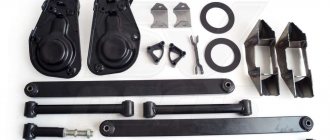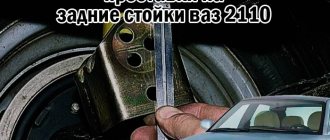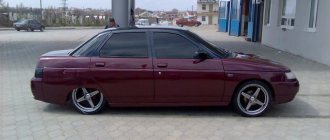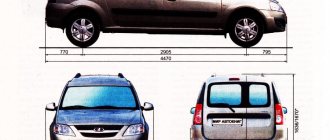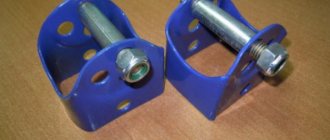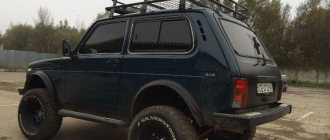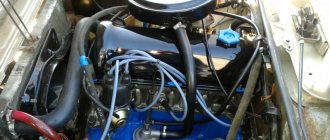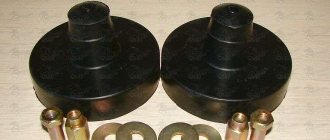Quite often, when driving on the road, there are times when the bottom of the car crosses the road. Such situations occur when you are driving on dirt roads or uneven areas. And you start to think why this is happening. And the reason is that each car has a different ground clearance, or as it is also called correctly, ground clearance. Let's take a closer look at our Chevrolet Niva car as an example; its ground clearance is quite high.
UAZ or Niva: differences in suspension design
The UAZ Hunter has a dependent leaf spring suspension, which is distinguished by its reliability when driving on mud and stones, but on the other hand, there is a complete lack of comfort.
That is why this car is called the “goat”. Compared to the Hunter, the ride on the Niva is softer, since the suspension here is different: independent in the front and dependent in the rear. In addition, the Niva also has power steering, ABS brakes and emergency brake assist.
As for the UAZ Hunter, its finishing is even more modest, but there is an opportunity to make tuning based on your taste preferences. Typically, Hunter owners purchase a winch, a protective bumper or a guardrail, and also install an additional trunk or gas tank. Since this is an off-road vehicle, it is usually made as functional as possible for off-road driving.
Patency
What kind of oil to pour into the transfer case of a Chevrolet Niva
But the car shows good results off-road. Even on road tires, which the car is equipped with from the factory, the SUV can get out of any “trap”, be it sand or wet primer. The Niva also performs well in the snow. And you can expand the cross-country ability only by installing more “evil” mud tires. The stores have a wide range of tires for Niva. This can be true MT mud tires, or universal AT, which is suitable for both asphalt and off-road. In addition, the car can be equipped with a power bumper with an electric winch. But usually three-door Nivas are prepared according to this principle.
What is the ground clearance of the Chevrolet Niva
UAZ Patriot, Chevrolet Niva and Lada 4x4
Ground clearance of any vehicle is one of the fundamental characteristics. And for the Chevrolet Niva SUV, this is the most important parameter, since it directly affects how the car will behave in off-road conditions.
The value of the ground clearance will determine whether the bottom of the car will cling to protrusions or bumps. After all, with low ground clearance, it risks hanging, losing the ability to move. This is why SUVs should have this distance as high as possible.
The Chevrolet Niva began rolling off the assembly line in 2002, and over such a long time managed to win the hearts of many car enthusiasts.
However, sometimes even this distance is not enough, so owners begin to be overwhelmed by thoughts of how to make the car a little higher.
Minor discrepancies
It happens that the manufacturer determines the clearance value at his own discretion. This means that it may be less than indicated in the vehicle documentation. You can find out the real ground clearance yourself, armed with a tape measure.
The manufacturer can also use a trick - indicate a value that is typical only for an empty car. But in reality, rarely does anyone drive completely empty:
- the luggage compartment is filled with various things (sometimes not entirely necessary);
- casual or regular travel companions;
- the driver himself.
In addition, you should not discount the age of the car and the wear of the suspension springs. With long-term use they sag noticeably.
Specifications
Technical parameters include not only the ground clearance of the Chevrolet Niva, but also other dimensions of the vehicle:
- length – 4,056 mm;
- height – 1,690 mm;
- width – 1,800 mm (excluding side mirrors);
- wheelbase – 2450 mm;
- width between the centers of the front wheels - 1,466 mm;
- The width between the centers of the rear wheels is 1,456 mm.
Brief history of the city
It has been scientifically proven that the local lands were inhabited back in the Neolithic era. Archaeologists have found mammoth bones and human remains here. The first settlement appeared approximately in 1140 - 1155. Written references date back to the 16th century; they stated that Skopin was the patrimony of the boyar family of the Romanovs. In 1605, the settlement was surrounded by a wooden fortress. Since the 17th century it has been called Skopinskaya Sloboda. Was part of the Azov province.
Officially received city status in 1778. Emperor Alexander I visited it. Since the 19th century, the economy has been actively developing, and trade has been on the rise. During the Great Patriotic War, the city was recaptured from enemy attacks in 3 November days in 1941. During the Soviet period, Skopin became the industrial center of the Ryazan region, new plants and factories were built, hundreds of jobs were created.
Skopin is an ancient city in the Ryazan region. It is located on the left bank of the Verda River.
During the formation of the centralized Russian state headed by Moscow, the southern regions of the Ryazan region were the first to repel the raids of nomads.
To protect the southeastern borders, the Moscow state is building a system of defensive fortifications - zaseki, a significant part of which is located on the territory of the Ryazan Territory.
Skopin of those years was surrounded by three earthen walls, “the quarter wall from the Verda River is a chopped wooden wall, near the town there are eight wooden towers, the ninth tower is earthen: and that town has only one gate.”
In 1613, the Russian throne was occupied by the elected tsar, boyar Mikhail Fedorovich Romanov, who put a lot of effort into creating a regular, well-trained army. At the beginning of the 17th century, Streletskaya, Pushkarskaya, and Cossack settlements grew in Skopin.
In the second half of the 17th century, Tsar Alexei Mikhailovich issued a charter on the purchase of grain in Ryazan cities. Carts with wheat, rye, oats, buckwheat, millet, pork, chickens and geese, sour cream and other food came from Skopin...
In 1663 Skopin entered the department of the Secret, then the Khlebny, and at the beginning of 1676 - the Streletsky orders. Skopin then became part of the Tsar's Stables Chancellery. With the construction of a new stable yard in 166Z behind Verda, the Skopinskaya stable settlement was formed. In 1708, Tsar Peter I Alekseevich assigned Skopin to the Azov province for ship matters, and in 1719 the city became part of the Yelets province of the Azov province. In 1725, the Azov province was renamed Voronezh.
In the 20s of the 18th century, Skopin completely lost its military significance. Now most of the population are merchant families.
In 1731, along with the adjacent villages, it was transferred to the department of the Stable Order. Skopinskaya volost became part of the Dankovsky district of the Yelets province of the Voronezh province. In this regard, all service people are transferred to the category of grooms and peasants of the palace stable office.
On August 24, 1778, with the establishment of the boundaries of the Ryazan governorship by the Palace Stables Chancellery, Skopin was approved as a city and the center of the county. On May 29, 1779, by decree of Empress Catherine II, Skopin received a coat of arms. The coat of arms consists of two parts: in the gold-colored upper part there is a silver sword and scabbard lying crosswise, above them there is a green princely cap; “in the second part of the shield in a blue field there is an osprey bird flying, meaning the name of this city.”
In the middle of the 19th century, in the section on the routes of communication of the Ryazan province, we read that Skopin is located on a busy place - the Transcaucasian or Lipetsk tract, which separated from the Astrakhan highway near the city of Ryazan and went through Pronsk, Skopin, Dankov, Tambov province and beyond.
In the same year, Alexander II signed the law on zemstvo.
Already in the fall of 1868, a member of the Skopin council, Ovchinnikov, reported on the construction of a hospital, on the construction of a large postal road from Skopin to the Korablinskaya station of the Kozlovsko-Ryazan railway through Sistovka, Letovo, Velikaya Luka and Dubovitsy, on the abolition of the large Ryazhsko-Pronskaya road, on the change of owners of the large Dankovskaya road.
In 1868, the first historiographical literature about Skopin appeared - “The Historical, Statistical and Contemporary Significance of the City of Skopin” by I. A. Alekseev.
In 1876, a real school was opened. There are plans to open a shelter for infants.
Updated Chevy Niva
Chevrolet Niva
The second generation Chevrolet Niva is a successful joint development of engineers. The car has good performance in terms of body strength, torsional rigidity, and paint quality. In terms of interior comfort, the SUV looks rather modest, and its main advantage is its off-road capabilities.
The decoration of the Chevrolet Niva is the updated radiator grille with a large golden logo. The head optics look original, with round fog lights located on the sides of the bumper. Plastic linings have appeared on the body sidewalls; in expensive trim levels, the SUV is equipped with 16-inch alloy wheels.
The Chevrolet Niva test can tell you about some of the features of the model, for example, that the car cannot be called dynamic. It will appeal to those drivers who prefer a quiet driving style. On the road, the Niva behaves quite acceptable, but the following feature is noted: it is necessary to change gear strictly on time, that is, when the engine reaches 3000-3500 rpm. The suspension also performed well during testing, allowing it to comfortably overcome obstacles on the roads. Off-road the car moves confidently and there is no need to even switch to a lower gear, but it is noted that if you get into a rut, you have to work hard to get out of it. At times the car does not have enough power to overcome certain obstacles, and the engine often stalls.
During the restyling, the Chevrolet Niva was improved in various ways in order to get rid of some shortcomings: for example, a leak in the engine cooling system was eliminated, the front suspension assembly was changed, and sound insulation was improved. All premium trim levels after 2013 received new seats, ABS, seat belts with pretensioner and front airbags. As for the power unit, it was made more dynamic and economical. Its volume is now 1.8 liters and its power reaches 122 hp. With. This engine is installed on a special modification marked FAM-1. The 1.7-liter engine on standard versions has a small power of 80 hp. With. The engine is coupled to a 5-speed manual transmission.
Ground clearance of the Niva Chevrolet car
Chevrolet Niva configurations
While driving a car, situations arise in which the bottom of the car rubs or scrapes the road. This happens when driving along damaged areas or dirt roads. When such problems arise, you begin to wonder why the car sticks to the asphalt so much. The thing is that each car has a different clearance height between the road and the bottom. This distance is called clearance. Ground clearance in any car is the distance from the lowest point of the car to the surface of the earth. It is also called ground clearance. Each model has a different clearance height. Let's consider the ground clearance and its characteristics for the Chevrolet Niva SUV.
Full technical specifications of Chevrolet Niva - summary table
| Parameter | Chevrolet Niva 1.7 80 hp |
| Engine | |
| Engine code | 2123 |
| engine's type | petrol |
| Injection type | distributed |
| Supercharging | No |
| Number of cylinders | 4 |
| Cylinder arrangement | in-line |
| Number of valves per cylinder | 2 |
| Volume, cubic cm. | 1690 |
| Power, hp (at rpm) | 80 (5000) |
| Torque, N*m (at rpm) | 127.5 (4000) |
| Transmission | |
| Drive unit | full |
| Transmission | 5 manual transmission |
| Suspension | |
| Front suspension type | independent multi-link |
| Rear suspension type | dependent |
| Brake system | |
| Front brakes | disk |
| Rear brakes | drums |
| Steering | |
| Amplifier type | hydraulic |
| Tires | |
| Tire size | 205/75 R15 / 205/70 R15 / 215/65 R16 |
| Disk size | 6.0Jx15 / 6.0Jx15 / 6.5Jx16 |
| Fuel | |
| Fuel type | AI-95 |
| Environmental class | Euro-5 (Euro-4*) |
| Tank volume, l | 58 |
| Fuel consumption | |
| Urban cycle, l/100 km | 13.2 (14.1) |
| Extra-urban cycle, l/100 km | 8.4 (8.8) |
| Combined cycle, l/100 km | 10.2 (10.8) |
| dimensions | |
| Number of seats | 5 |
| Number of doors | 4 |
| Length, mm | 4048 |
| Width, mm | 1770 |
| Height, mm | 1652 |
| Wheelbase, mm | 2450 |
| Front wheel track, mm | 1466 |
| Rear wheel track, mm | 1456 |
| Front overhang, mm | 721 |
| Rear overhang, mm | 748 |
| Trunk volume (min/max), l | 320/650 |
| Ground clearance (clearance), mm | 200 |
| Geometric parameters | |
| Entry angle, degrees | 37 |
| Departure angle, degrees | 35 |
| Weight | |
| Curb (min/max), kg | 1410 |
| Full, kg | 1860 |
| Maximum trailer weight (equipped with brakes), kg | 1200 |
| Maximum trailer weight (not equipped with brakes), kg | 600 |
| Dynamic characteristics | |
| Maximum speed, km/h | 140 |
| Acceleration time to 100 km/h, s | 19.0 |
* – engine data before modernization in 2015 is indicated in brackets.
| Parameter | Chevrolet Niva 1.7 80 hp | Chevrolet Niva 1.8 122 hp |
| Engine | ||
| Engine code | 2123 | Z18XE |
| engine's type | petrol | |
| Injection type | distributed | |
| Supercharging | No | |
| Number of cylinders | 4 | |
| Cylinder arrangement | in-line | |
| Number of valves per cylinder | 2 | 4 |
| Volume, cubic cm. | 1690 | 1797 |
| Power, hp (at rpm) | 80 (5000) | 122 (5600) |
| Torque, N*m (at rpm) | 128 (4000) | 167 (3800) |
| Transmission | ||
| Drive unit | full | |
| Transmission | 5 manual transmission | |
| Suspension | ||
| Front suspension type | independent multi-link | |
| Rear suspension type | dependent | |
| Brake system | ||
| Front brakes | disk | |
| Rear brakes | drums | |
| Steering | ||
| Amplifier type | hydraulic | |
| Tires | ||
| Tire size | 205/70 R15 | |
| Disk size | 6.0Jx15 | |
| Fuel | ||
| Fuel type | AI-92 | |
| Environmental class | n/a | |
| Tank volume, l | 58 | |
| Fuel consumption | ||
| Urban cycle, l/100 km | 14.2 | 12.8 |
| Extra-urban cycle, l/100 km | 8.9 | 8.5 |
| Combined cycle, l/100 km | 10.9 | 10.1 |
| dimensions | ||
| Number of seats | 5 | |
| Number of doors | 4 | |
| Length, mm | 4048 | |
| Width, mm | 1770 | |
| Height, mm | 1652 | |
| Wheelbase, mm | 2450 | |
| Front wheel track, mm | 1450 | |
| Rear wheel track, mm | 1440 | |
| Trunk volume (min/max), l | 320/650 | |
| Ground clearance (clearance), mm | 200 | |
| Weight | ||
| Curb (min/max), kg | 1400 | 1520 |
| Full, kg | 1850 | 1870 |
| Maximum trailer weight (equipped with brakes), kg | n/a | n/a |
| Maximum trailer weight (not equipped with brakes), kg | n/a | n/a |
| Dynamic characteristics | ||
| Maximum speed, km/h | 140 | 165 |
| Acceleration time to 100 km/h, s | 19.0 | 12.0 |
Price policy
For Niva 21214, the price, depending on the showroom and dealer, is about 370-380 thousand rubles - this is the “Standard” package. When ordering additional options, it may increase slightly.
BRIEF CHARACTERISTICS FOR LADA 4X4 (3 doors) 1.7 L 8 KL. (83 HP), 5MT (2017)
BRIEF CHARACTERISTICS FOR LADA 4X4 (5 doors)
BRIEF SPECIFICATIONS FOR LADA 4X4 Urban (3 doors)
DETAILED TECHNICAL CHARACTERISTICS OF VAZ-21213 and 21214 CARS
VAZ-21213 and its modifications are all-terrain passenger cars. All wheels are constantly driven (non-disconnectable all-wheel drive), there is a center differential locking mode. The body is load-bearing, all-metal, welded. Engine – four-cylinder, in-line, petrol, four-stroke; location – anterior, longitudinal. The VAZ-21213 is equipped with a carburetor engine mod. 21213 with a displacement of 1.7 liters, on the VAZ-21214 - engine 21214 of the same volume with distributed fuel injection. (Previously, VAZ-21214 cars were equipped with a 21214 engine with central fuel injection and a microprocessor ignition system). VAZ-21215 (supplied for export) is equipped with a diesel engine XUD-9SD with a displacement of 1.9 liters from the Peugeot-Citroen concern.
VAZ-21214 vehicles are equipped with a toxicity reduction system with a three-component neutralizer. To avoid failure of the converter and oxygen sensor, it is prohibited to operate these vehicles on leaded gasoline.
Options
VAZ-21213
All-metal, load-bearing, two-volume
Number of seats (with rear seats folded)
Curb weight, kg
Total weight, kg
Ground clearance of a vehicle with a full load with a static tire radius of 315 mm (175/80R16)/ 322 mm (6.96-16), not less, mm:
221/228
Total weight of the towed trailer, kg:
400
Minimum turning radius along the track of the outer front wheel, m
Maximum speed*, km/h:
137
Acceleration time* from standstill to 100 km/h, s:
19
Maximum incline overcome by a vehicle with a full load without accelerating in first gear, %
VAZ 21214 is a passenger car, characterized by increased cross-country ability, equipped with a five-speed gearbox and a transmission with permanent all-wheel drive. In addition, there is a two-stage transfer case. Body type - “Hatchback”, the morally and technically outdated “four-speed” gearbox, which was equipped with previous models, was replaced on 21214 by a more modern and functional five-speed gearbox.
Features of luggage compartments
To summarize, let’s say that the Niva’s trunk is really small in volume – less than 400 liters. But due to the space freed up after the rear seats are removed, it becomes more spacious. Railings became a bonus for some models. You can finish the conversation about the features of the Chevy trunk with a simple comparison with the Granta liftback.
With a volume of 440 liters in the Granta's trunk, its capacity, as practice shows, is significantly lower due to the peculiarities of the geometry of the space. The square trunk of the Niva turns out to be much more rational to use than the Grant one, which is more voluminous in terms of technical characteristics, but is “cut off” by the inclined glass of the door.
The car does not have a truly spacious trunk. Therefore, before purchasing, you should decide how important this criterion is for you, and choose a car model based on this.
Chevrolet Niva
Both cars are frameless, with five-door station wagon bodies typical of all-wheel drive vehicles. The Duster has a longer wheelbase - 2673 mm versus 2450 mm for the Chevrolet Niva. It is clear that the additional centimeters allow passengers and luggage to be more comfortably accommodated, and also provide a bonus for stability and smoothness. However, off-road, the plus turns into a minus, significantly worsening the geometric cross-country ability.
The only Chevy engine is capable of producing only 80 horsepower and 127.5 Nm - it won’t show off its dynamics on the highway. And off-road, all hope lies only in the “wide” transmission.
“Duster” is richer in this regard. Three engines to choose from, one of them diesel. By the way, both the younger ones - both the petrol (1600) and the diesel (1500) - are more powerful than the Nivov 1700, and even richer in torque. The power unit is on a subframe, which means less vibration is transmitted to the body.
In terms of transmission, the Niva is a true all-terrain vehicle. The transfer case gives this car two full five-speed rows of gears. And in particularly difficult conditions, locking the center differential helps. Crosspieces on cardan shafts are a thing of the past, giving way to CV joints. Thus, nothing needs to be injected during operation.
The six-speed Duster is a half solution for serious off-road conditions (mud, sand and deep snow). In these conditions, you can at least move forward on the first lower gear, but you won’t be able to go back. Due to lack of torque on the wheels, the clutch will burn out. And the switching pattern with starting on hard roads from the second is not the most convenient. It was easier to remove the low gear from the general row and hide it under the flag - opposite the rear one. Then the asphalt part of the gearbox would turn into a five-speed gearbox with conventionally spaced steps.
If necessary, the electromagnetic clutch automatically turns the car into all-wheel drive - quite convenient. However, if it slips for a long time, for example, in deep snow, it will definitely overheat and for some time transfer all the hardships of fighting off-road conditions to one axle.
The car suspensions are completely different. The Niva has an independent front with parallel levers. The design is traditional for such machines - as they say, time-tested. This ensures a smooth ride at high speed and holds the impact on rough terrain.
The rear suspension is dependent. The design, one might say, is ancient: a beam with five rods (four longitudinal and one transverse) is familiar from the Zhiguli. A special feature of this suspension is its constant ground clearance.
The Duster has a modern and more passenger-friendly McPherson in front. Good on relatively smooth roads, but not durable enough off-road. It is this suspension that provides easy handling with clear reactions and a high smooth ride.
The brakes on the Niva are not the most modern. Disc in front, drum in back. The Duster's front brakes are ventilated discs, more effective at high speeds. The rear ones are drum-type, with a diameter smaller than that of the Niva, which shifts the load to the front ones.
The steering on both cars is power-assisted, which eats up engine power even when the wheels are in the “straight” position.
So, the Chevrolet Niva is a real all-terrain vehicle. Its inherent disadvantages (modest trunk, increased noise and vibration) are due to its purpose and design features.
“Duster”, translated from English as “duster”, exactly corresponds to the name. This is a more comfortable front-wheel drive passenger car with a temporarily connected rear axle. Spacious, with large wheels and good geometric cross-country ability, which allows it to dust on dirt roads more confidently than ordinary passenger cars. But off-road it can’t keep up with the Niva.
Owner reviews
- Igor, Perm. The car was purchased in 2015, in new condition. The car was bought out of desperation, so to speak. I didn't have the money for anything worthwhile, but I needed a car with serious off-road potential. I could have taken the UAZ Patriot, but in the end I considered it a stupid idea - it cost even more. And the Niva is more compact and maneuverable, and in cross-country ability it is almost as good as the Patriot. Despite the outdated design, the car is capable of giving driving pleasure. The handling is almost like a car, but when cornering the car rolls a lot - due to the high ground clearance and large tires, as well as the high body. In city traffic the car has enough power, but on a country road you have to put the pedal to the floor and burn fuel. At this rate, fuel consumption will easily exceed 12 liters.
- Sergey, Vologda. I'm driving a 2012 Niva. Before Shniva, I had a Moskvich 2140 - also a good cross-country vehicle, despite the fact that it is a passenger car. And the Chevrolet Niva is a full-fledged SUV without any discounts. The car was purchased in 2022, with a mileage of 70 thousand kilometers. A modest 80-horsepower engine consumes an average of 11-12 liters per 100 km. Ground clearance of 200 mm is enough for any off-road obstacles. In addition, minimal body overhangs contribute to high cross-country ability, unlike fashionable imported crossovers. Niva beats all its competitors; you can handle any off-road conditions, including deep snowdrifts, without any strain.
- Yuri, Moscow. My experience in operating Chevrolet Niva is six years. Since 2012, the mileage has increased to 113 thousand kilometers. I will say right away that the car is completely unreliable. Something is constantly falling off, creaking and making noise. At idle, there is a shuddering sound all over the bottom. You can get used to this, especially if you have ridden VAZs before. The ergonomics are all right, unless, of course, you turn a blind eye to the cheap finishing materials and outdated design of the front panel. The instrument panel is clear and informative; it does not become blind in the sun. Due to the ground clearance of 200 mm, you can park near high curbs without worrying about damaging the bumpers, which are mounted quite high. The Chevrolet Niva is not for high speeds, and in dynamic driving mode large rolls occur when cornering. The engine develops 80 horsepower, and this is frankly not enough for an SUV. Enough for the city.
- Vladimir, Yaroslavl. The Chevrolet Niva has a very weak engine - we found ways to save money. In addition, I can also complain about the dead clutch, and at the slightest start I have to shift into a lower gear. Otherwise, there is a possibility of rapid wear of the clutch - it heats up and begins to stink. As for the dispenser, it’s a different matter – to turn it on and then turn it off, you have to work hard. The unit is very tight, it needs to be lubricated more often. Due to the ground clearance of 200 mm, the car noticeably yaws on the road, rolls in turns and leaves the trajectory. You need to taxi regularly and be constantly on alert. When opening doors, rubber seals constantly shuffle, especially in frosty conditions. The car consumes 12 liters in the urban cycle. Consumption may increase if you sit in traffic jams for a long time. The cabin is relatively spacious for all five passengers, despite the short wheelbase.
- Vladislav, Nizhny Novgorod. I bought Shniva in 2014. A normal car for the money. I praise the car for its soft and comfortable suspension and spacious interior. The car is very convenient for rural conditions, off-road and any bad roads. All-wheel drive could be switchable to increase efficiency, but VAZ decided to save money on this. On the other hand, with all-wheel drive the car handles better than a regular front-wheel drive car like the VAZ-2106. I have the version after restyling. In my opinion, the design of the car is not outdated yet. The car looks quite modern for a budget employee. A ground clearance of 200 mm has a beneficial effect on cross-country ability, and this is important for me, since I often drive along country lanes and deep snowdrifts. I am not going to sell the Niva yet, since the car is still intact, it is reliable, dynamic and maneuverable. The car rolls a little, but rolls are acceptable off-road.
- Vasily, Volzhsky. I have been using the car since 2002. I bought Shniva as soon as it went on sale. I had hope that the Russian auto industry was not giving up, and that it had finally created something worthwhile, similar to modern foreign cars. In practice, it turned out to be the opposite. In the first thousand, breakdowns occurred every day, then the situation calmed down a little - the parts got used to it, and there were fewer breakdowns. The car is unstable on the highway and only shows its potential off-road. The car is gluttonous, scours from side to side, you have to constantly steer. The ground clearance is 200 mm, which is sufficient for a city crossover.
- Nikolay, Balashikha. I have a Chevrolet Niva in the maximum configuration. The car is 2013. I gave myself a gift for February 23, because I am a military pensioner. You need to pamper yourself with something in your old age. By the way, before Chevy I drove the Soviet Niva 2121, I drove it for about 12 thousand km. It’s also a good car, but I decided to sell it because the opportunity arose to buy a more modern car – an updated 2013 Chevrolet Niva. The car's handling feels better, as does its comfort. It feels like the Chevrolet has better sound insulation. Engineers also worked on the steering. Steering reactions are clear and predictable. On the highway you can safely drive at 120 km/h - the car is absolutely stable and there is no need to steer. Then “dancing with a tambourine” begins, so to speak, so I don’t recommend accelerating above this speed. The fuel consumption of the version with an 80-horsepower engine is within 12-13 liters in the urban cycle. I liked the car’s cross-country ability due to the ground clearance of 200 mm and minimal body overhangs. All-wheel drive is configured as it should, and there is also a transfer case.
How to increase clearance using suspension
First, you need to remove the old “shoes” from the car, which are replaced with wheels with increased dimensions. Before installing them, appropriate physical adjustments should be made to ensure that nothing interferes. We are talking about straightening arches with a grinder. If you have confidence in your own abilities, then the work can be easily completed by the owner himself. Otherwise, it is better to contact a car service.
As for the exact size, the diameter should be selected no more than 30% of the original tire size. Also, the decision to put wheels of a larger diameter on the car than required increases the load on the power unit - after all, the manufacturer did not just select the right size.
After the car has received new “shoes”, you should definitely check the steering angles of the front wheels. Perhaps they will touch the body
To correct the nuance, it is recommended to pay attention to rims with a large offset parameter. However, such a step increases the load on all bearings and accelerates their wear.
After this, to increase the ground clearance of the Chevy Niva, the following manipulations are necessary:
- Install special spacers on the platforms under the springs, which places additional load on the suspension arms.
- Next is the turn of the steering knuckles - you need to change their location relative to each other. In addition, it is necessary to turn the tie rod ends up. As a result, they will not rest against the stabilizer.
- Next, the elastic elements, anthers, and shock absorbers are changed.
In addition, the rear suspension needs to be re-equipped. To do this, change the cups into which the rear springs rest, as well as the shock absorber mounts. The axle bars behind the car need to be lengthened.
Lifting rules
Increasing clearance is a labor-intensive procedure. It requires special skills and tools. Therefore, lifting is usually performed at a service station. However, if you have the skills, you can install the lift kit yourself
In this case, it is necessary to pay attention to the following points:
- Lifting requires an integrated approach. Simultaneously with the increase in ground clearance, it is necessary to change the shock absorbers and thrust rods. Otherwise, the suspension lift will make the car unusable.
- On the right side of the rear of the body there is a gas tank with ventilation pipes. This must be taken into account if, in addition to lifting, you decide to enlarge the wheel arches.
- If there is a significant change in ground clearance, you should install an extended brake hose and adjust the bump stops. You will also have to reconfigure the pressure regulator in the rear brake circuit.
For tuning at home, it is better to use ready-made factory-made lift kits.
Trunk tuning
To increase the luggage compartment and make it ergonomic, it is recommended to install an insert on a Niva car. To purchase an organizer. If available, it is worth stocking up on a complete set, which consists of:
- shelf amplifiers;
- pockets on the fifth door;
- organizers that are placed under the shelves of the car;
- trunk pockets.
If the car already has an organizer, then you can increase the trunk by installing pockets. These devices provide the ability to accommodate a large number of things that are small and medium in size.
Basic configurations of Chevrolet Niva
Chevrolet NIVA is manufactured in the following configurations:
- L;
- L.C.;
- LE;
- GL;
The first three are considered basic, with minimal equipment, the last two are the maximum possible assembly (see photo).
The range of power plants on the Chevrolet Niva is typical - a four-cylinder petrol engine with a volume of 1.7 liters and a power of 80 hp. Power units comply with Euro 4 standard.
Basic versions are equipped with: central locking, electric windows, power steering, alarm system, and hydraulic headlight leveling. The rear row of seats folds in a 60/40 ratio.
The LC has pre-installed air conditioning, the GLS and GLC have improved interior trim, artificial leather inserts, and other decorative trims. And also, heated seats, alloy wheels, fog lights.
The LE version has a special role - the model is prepared for off-road driving. Externally, “LE” is easy to distinguish from analogues by a pre-installed antenna and roof rails, an external air intake, and a winch on the front bumper.
Suspension: front double wishbone, independent, rear multi-link, dependent. The suspension is a bit harsh, but just right for off-road driving. Braking system: front disc and rear drum brakes.
Considering that the car's design was developed in the late 90s, it does not meet many modern requirements. In order to “stay afloat” the manufacturer has to quickly refine modifications of the Niva.
Thus, three years after the presentation of the first generation, the Chevrolet Niva (FAM-1) model was released. The safety system has been improved, moreover, it is passive, the ABS system and belt pretensioners are pre-installed.
Since 2015, similar equipment has been included in series production for the GLS and GLC. The shape of the seats has been changed, now they have obvious lateral support, which was so lacking in previous versions.
GLS and GLC versions
The price tags for the top trim levels are not off the charts, but they still differ significantly from the price of the most budget version: 469 thousand rubles for the “base” version versus 540 and 567 thousand for the GLS and GLC, respectively. What is so fundamentally different about the best version of the SUV we are considering, that the difference between it and the “minimum wage” is almost 100 thousand rubles?
First of all, the top version is distinguished by its coloring, or more precisely, the method of painting: both the side mirrors and door handles are painted in the body color, which makes the car’s exterior more complete. Instead of standard wheels, the luxury version has 16-inch cast wheels, which gives the car a more confident and massive look.
Striking differences can also be found in the interior: after all, the artificial leather covering is superior to the “rag” covering in almost all respects. In addition, the rear seats in the “luxury” have comfortable L-shaped headrests, a special eyeglass case, additional lighting in the rear of the cabin and a pair of decorative trims on the front panel. Those who like to smoke in the cabin will be pleased with the removable ashtray with a chrome-plated lid rim.
In addition to all of the above, the GLS and GLC versions include heated front seats, isothermal windows, fog lights, a special spare tire holder (made of aluminum), a cabin air filter, an ABS system, a seat belt pretensioner for the front passenger and driver, and a pair of airbags safety for them.
Having started production of this SUV back in 2002, manufacturers did not stop working on its modernization for a year, regularly adding new options to the car, making adjustments to its design and promptly eliminating design defects that arose during long-term operation.
Features of the Chevrolet Niva car
What are the differences between the Chevrolet Niva and the regular model? The design of the SUV is made in a different style, which is close to the Chevrolet model range. The back door began to open to the side, and not upward, as before. The VAZ-2121 had a spare wheel in the engine compartment, but now it is mounted on the door. As for the power unit, transmission and suspension, they have not undergone significant changes. The Chevrolet Niva is equipped with frost-resistant bumpers, and the color range of the body has expanded.
The advantages of the Chevy Niva compared to other cars are not limited to the lightness of the design and, accordingly, increased cross-country ability. The main rival of this model is the Renault Duster: unlike it, the SUV described is equipped with permanent all-wheel drive. "Chevrolet Niva" combines the comfort of a city SUV and the advantages of the old model. But there are also disadvantages, such as a weak motor and a low level of safety. However, despite a number of disadvantages, this SUV became the best-selling in the period from 2004 to 2008. “Chevrolet Niva” has a number of awards, such as “SUV of the Year” in two SUV categories and “Premiere of the Year”, and was also awarded the “High Performance Award”.
Waiting for the release of a new generation model
Soon the third generation of the popular domestic SUV model was supposed to roll off the assembly line, but, as the manufacturer announced, the project was frozen, and the new generation will be born only by 2022 at best. The updated Niva was presented in 2014 at the Moscow auto exhibition, but in order to launch it into mass production, about 12–14 billion rubles are required. Due to the financial problems of VAZ, the government of the country is ready to provide it with support in the form of issuing a loan for the development of the project. As a result, the Chevrolet Niva car will be radically different from its predecessor, but the main distinctive features will still be preserved.
Specialists of the American auto giant GM developed a new appearance and technical part of the car, and also modified the interior. The exterior features many angular shapes and stylish stamps, as well as an additional off-road body kit. The Chevrolet Niva will still remain a real SUV, because this is exactly what fans of the brand want. It will, as before, be equipped with a permanent all-wheel drive system and also have high ground clearance. The Chevrolet Niva is equipped with a modified suspension and large mud tires. It is noted that now there will be modifications with a single-axle drive, as well as with a manual transmission.
Increasing ground clearance using the body method
This technique is not as complicated as the first one, since there is no need to radically interfere with the car’s design, which will allow it to maintain its center of gravity. Accordingly, this will not affect handling either.
The operating principle is as follows:
- Special washers are placed under the springs - this is the simplest method to slightly raise the car.
- Volga shock absorbers are installed in front, and springs are installed in the rear instead of shock absorbers. The elastic elements should be taken from the Gazelle - the clearance will be increased, but the center of gravity will remain the same.
However, along with simplicity, this method of increasing the ground clearance of the Niva Chevrolet has a number of disadvantages:
- due to the extreme angle when cornering, CV joints (grenades) wear out faster;
- the anthers are subject to frequent stretching and also wear out faster;
- Due to rapid wear, the parts become very hot, so in general the method is not highly effective.
If the owner decides to raise his car for frequent off-road trips, he should choose the first method. Although this case will require large financial and labor investments, it is much more effective.
Advantages and disadvantages
Installing a lift kit has an ambiguous effect on the driving performance of the car. The advantages of this type of tuning include:
- Increased ground clearance.
- Improved machine design.
- Possibility of installing larger wheels and mud tires with large lugs.
- Improving cross-country ability on rough terrain.
- Reduces the likelihood of damage to the engine crankcase, exhaust pipe or transmission.
However, the suspension lift not only has a positive effect on the characteristics of the Chevrolet Niva.
A change in the factory design manifests itself in the form of the following disadvantages:
- The breaking angle of CV joints increases. This reduces the service life of the drives.
- The center of gravity rises. The car's behavior when cornering worsens and the likelihood of capsizing increases.
- The load on the transmission and chassis is growing. As a result, parts wear out faster.
Extreme tires
Classic mud tires, have a large tread pattern, lateral lugs, and are soft enough to handle off-road use. Designed for use when you ride 80 percent of the way on dirt and only 20 percent on the highway. It wears out very quickly when driving on asphalt.
Most often used on large SUVs, because the size range of most models starts from 29-31 inches. Nivovoda fans also install 31″ tires, having seriously modified the car beforehand. Extreme tires have a very large tread pattern, powerful lugs for driving out of ruts, are very soft and are absolutely not intended for driving on the highway.
